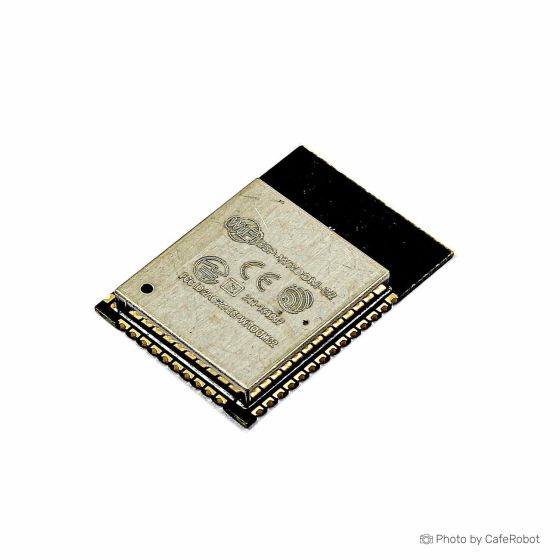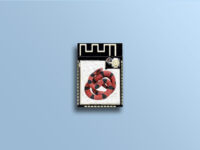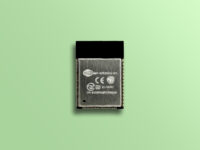ماژول ESP32-WROOM-32 دارای حافظه فلش 4 مگابایت
-
 ماژول ESP32-WROOM-32 دارای حافظه فلش 4 مگابایت
ماژول ESP32-WROOM-32 دارای حافظه فلش 4 مگابایت
COM-03-043 -
 ماژول ESP32-WROOM-32 تولید Espressif
ماژول ESP32-WROOM-32 تولید Espressif
COM-03-093 -
 ماژول ESP32-WROVER-B دارای حافظه فلش 16 مگابایت تولید Espressif
ماژول ESP32-WROVER-B دارای حافظه فلش 16 مگابایت تولید Espressif
COM-03-042 -
 ماژول ESP32-WROOM-32U تولید Espressif
ماژول ESP32-WROOM-32U تولید Espressif
COM-03-092 -
 ماژول ESP32-WROOM-32D تولید Espressif
ماژول ESP32-WROOM-32D تولید Espressif
COM-03-091 -
 ماژول ESP32-WROVER-IB تولید Espressif
ماژول ESP32-WROVER-IB تولید Espressif
COM-03-094
- +25 5 % 250٬100 تومان
- +50 7 % 244٬000 تومان
- +100 9 % 237٬800 تومان
- +300 12 % 231٬600 تومان
- +500 14 % 225٬500 تومان
توجه : متن حکاکی روی بخش آلومینیومی ESP-32 می باشد.
ماژول ESP32-WROOM-32 انتخابی ایدهآل برای کسانی است که نیاز به اتصال وایفای و بلوتوث در یک بستهبندی کوچک و با هزینهی مناسب دارند. این ماژول با استفاده از چیپ ESP32 و آنتن داخلی PCB طراحی شده و به دلیل عملکرد بالا و هزینهی پایین، بهطور گسترده در پروژههای اینترنت اشیا، هوشمندسازی خانه، شبکه کردن سنسورها و ... استفاده میشود. ESP32 دارای دو هسته پردازشی است که هر کدام بهصورت جداگانه قابل کنترل هستند و در فرکانسهای 80 مگاهرتز تا 240 مگاهرتز کار میکنند. این ماژول انواع مختلفی از تجهیزات جانبی مانند سنسورهای لمسی خازنی، سنسورهای اثر هال، UART، I2C و ... را پشتیبانی میکند و برای پروژههای پیچیده مناسب است.
مشخصات فنی ماژول ESP32-WROOM-32
- میکروکنترلر: ESP32-D0WDQ6 (دو هستهای، میکروپردازندههای 32 بیتی Xtensa® LX6)
- فرکانس CPU: تا 240 مگاهرتز
- حافظه فلش: 4 مگابایت
- SRAM: 520 کیلوبایت روی تراشه، 8 کیلوبایت RTC SLOW، 8 کیلوبایت RTC FAST
- ROM: 448 کیلوبایت برای بوت و توابع اصلی
- وایفای: 802.11 b/g/n/d/e/i/k/r (تا 150 مگابیت در ثانیه)
- بلوتوث: نسخه 4.2 BR/EDR و BLE
- امنیت: پروتکلهای WPA/WPA2/WPA2-Enterprise و رمزگذاری AES/RSA/ECC/SHA
- رابطها: کارت SD، UART، SPI، SDIO، I2C، PWM (LED و موتور)، I2S، IR، GPIO، حسگر لمسی خازنی، ADC، DAC، سنسور هال، سنسور دما
- ولتاژ عملکرد: 2.2 تا 3.6 ولت
- مصرف توان: بهطور معمول 80 میلیآمپر
- دمای عملکرد: -40 تا +85 درجه سانتیگراد
- ابعاد: 18 میلیمتر × 20 میلیمتر × 3 میلیمتر
ویژگیهای ماژول ESP32-WROOM-32
- پردازش دو هستهای: دارای دو هسته پردازشی است که توانایی اجرای همزمان وظایف پیچیده را فراهم میکند.
- وایفای و بلوتوث یکپارچه: اتصال وایفای و بلوتوث یکپارچه برای ارتباطات بیسیم در پروژههای اینترنت اشیا و دستگاههای هوشمند.
- اتصالات گسترده: پینهای GPIO و رابطهای مختلف برای اتصال سنسورها، عملگرها، نمایشگرها و سایر قطعات، مناسب برای توسعه پروژههای چند منظوره.
- ویژگیهای امنیتی: پروتکلها و رمزگذاری پیشرفته برای اطمینان از امنیت انتقال دادهها در برنامههای بیسیم.
نکات استفاده
- کد خود را برای اجرای موازی روی هر دو هسته بهینه کنید تا از توان پردازش دو هستهای بهرهمند شوید.
- اطمینان حاصل کنید که تمامی قطعات و لوازم متصل به ماژول در محدوده ولتاژ 3.3 ولت عمل کنند تا از آسیب جلوگیری شود.
هشدار
- هنگام شارژ، بار متصل به ماژول را قطع کنید تا از تداخل در فرآیند شارژ جلوگیری شود.
- ماژول و قطعات را با دقت جابهجا کنید تا از تخلیه الکترواستاتیک و آسیب فیزیکی جلوگیری شود. هنگام ارتباط با مدارها یا دستگاههای خارجی، به حفظ یکپارچگی سیگنال و جلوگیری از ناسازگاری سطوح ولتاژ توجه کنید.
بردهای توسعه مبتنی بر ESP32-WROOM-32
بردهای توسعه زیادی مانند ESP32 DevKit و WeMos D1 بر پایه ماژول ESP32-WROOM-32 موجود هستند که اغلب شامل مبدل USB به سریال میشوند تا برنامهنویسی و ارتباط با ESP32 را آسانتر کنند.
انواع مختلف ESP32-WROOM-32
- ESP-WROOM-32D: دارای حافظه فلش SPI داخلی برای افزایش ظرفیت ذخیرهسازی، مناسب برای برنامههایی که نیاز به حافظه برنامه یا داده بیشتری دارند.
- ESP-WROOM-32E: دارای گزینههای مختلف آنتن یا فرمفاکتور برای مطابقت با نیازهای طراحی خاص.
- ESP-WROOM-32U: شامل کانکتور U.FL برای آنتن خارجی، ارائه انعطافپذیری در انتخاب و قرارگیری آنتن، که میتواند در سناریوهایی که آنتن PCB استاندارد عملکرد یا محدوده مطلوب را ندارد، مفید باشد.
مقایسه با سایر میکروکنترلرها
- ESP32: معماری دو هستهای با فرکانس قابل تنظیم تا 240 مگاهرتز، ارائه توان پردازشی بالا برای انواع کاربردها.
- بردهای آردوینو: معمولا 8 بیتی با فرکانس پایینتر، مناسب برای کاربردهای سادهتر.
- سری STM32F4: مبتنی بر هسته ARM Cortex-M4، تعادلی بین معماری 32 بیتی و فرکانس ساعت برای کاربردهای پیچیدهتر.
برای مطالعه بیشتر در مورد پینهای ESP32-WROOM-32، به "آموزش جامع انواع پایه های میکروکنترلر ESP32"
مراجعه کنید.
The ESP32-WROOM is a versatile development board based on the ESP32 microcontroller, which offers dual-core processing, Wi-Fi, and Bluetooth capabilities. Designed to provide extensive wireless connectivity options, the ESP32-WROOM is suitable for a wide range of applications, including Internet of Things (IoT) projects, smart devices, and wireless communication systems. With its powerful processing capabilities and diverse connectivity features, this board serves as an excellent platform for creating advanced and feature-rich projects.
Specificatoins of ESP-WROOM-32 ESP32 Board:
- Microcontroller: ESP32-D0WDQ6 (dual-core)
- CPU Frequency: Up to 240 MHz
- Flash Memory: 4 MB
- SRAM: 520 KB
- Wi-Fi: 802.11 b/g/n
- Bluetooth: Bluetooth 4.2 BR/EDR and BLE
- Digital I/O Pins: 38
- Analog Input Pins: 18
- UART, SPI, I2C, PWM, ADC, DAC interfaces
- USB-to-Serial Chip: CP2102
- Operating Voltage: 3.3V
- Dimensions: Varies based on board design
Features of ESP-WROOM-32 ESP32 Board:
- Dual-Core Processing: The ESP32-WROOM features two processing cores, offering enhanced multitasking capabilities for demanding applications.
- Wi-Fi and Bluetooth: With integrated Wi-Fi and Bluetooth capabilities, the board enables seamless wireless communication for IoT, smart devices, and wireless control.
- Extensive Connectivity: The board provides various GPIO pins, making it suitable for connecting sensors, actuators, displays, and other components to create feature-rich projects.
- Usage Tip: Leverage the power of dual-core processing by optimizing your code for parallel execution on both cores. Utilize the Arduino IDE or other compatible development environments to program the ESP32-WROOM.
- Caution: Ensure that components and peripherals connected to the board operate within the 3.3V voltage range to avoid damage. Handle the board and components carefully to prevent static discharge and physical damage. Take care when interfacing with external circuits or devices to maintain signal integrity and avoid voltage level mismatches.
ESP-WROOM-32 Pinout
The ESP32 WROOM-32 module has a specific pinout configuration that includes various GPIO (General Purpose Input/Output) pins, power supply pins, communication interfaces, and other essential connections.
For a deep study of ESP32-WROOM-32, please visit ESP32 Pinout Reference: A Comprehensive Guide
Development Boards Based on ESP32-WROOM-32:
In addition to the module itself, there are various development boards based on the ESP32 WROOM, such as the ESP32 DevKit, WeMos D1, and others. These boards often include USB-to-serial converters, making it easier for users to program and interface with the ESP32.
What is the difference between ESP32-WROOM-32 D,U and E series?
- ESP-WROOM-32D: The ESP-WROOM-32D is a variation of the ESP-WROOM-32 that includes an additional integrated SPI flash memory. This extra memory provides expanded storage capacity, making it suitable for applications that require more program memory or data storage. The standard ESP-WROOM-32, on the other hand, does not have this integrated SPI flash memory. Therefore, the ESP-WROOM-32D is specifically designed to offer enhanced storage capabilities compared to the standard ESP-WROOM-32 module.
- ESP-WROOM-32E: Variations such as the ESP-WROOM-32E may feature different antenna options or form factors to accommodate specific design requirements, offering users flexibility in selecting a module that aligns with the needs of their IoT projects.
- ESP-WROOM-32U: This variation typically includes an integrated U.FL connector for an external antenna, providing flexibility in antenna selection and placement, which can be advantageous in scenarios where the standard PCB antenna of the ESP-WROOM-32 may not provide the desired range or performance.
Speed comparison between ESP-WROOM-32 and other MCs
Comparing the processor speeds of different microcontrollers, such as the ESP32, Arduino boards, and the STM32F4 series, involves considering factors like clock frequency, architecture, and performance. Here's a general comparison:
ESP32:
- Processor: Dual-core Tensilica LX6 microprocessors
- Clock Frequency: Adjustable up to 240 MHz
- Architecture: 32-bit RISC
- Notes: The dual-core architecture of the ESP32 provides additional processing power and flexibility for multitasking.
Arduino Boards (e.g., ATmega328p on Arduino Uno):
- Processor: ATmega328p
- Clock Frequency: Typically 16 MHz
- Architecture: 8-bit AVR
- Notes: Arduino boards, including the popular Arduino Uno, use 8-bit AVR microcontrollers with a lower clock frequency compared to the ESP32. While suitable for many applications, they may have limitations in processing power and memory compared to more advanced microcontrollers.
STM32 boards (F4 series like STM32429I or STM32407):
- Processor: ARM Cortex-M4 core (32-bit)
- Clock Frequency: Depending on the specific STM32F4 variant, clock frequencies can range from tens of MHz to over 180 MHz.
- Architecture: ARM Cortex-M4 (32-bit)
- Notes: The STM32F4 series, based on the ARM Cortex-M4 core, is a 32-bit microcontroller series that offers higher performance compared to 8-bit AVR microcontrollers. The STM32F4 series is known for its processing power, extensive peripheral set, and suitability for more demanding applications.
- Comparison Summary:
The ESP32 stands out with its dual-core architecture and adjustable clock frequency up to 240 MHz, providing significant processing power for a variety of applications.
Arduino boards, using 8-bit AVR microcontrollers, have a lower clock frequency and are often used for simpler applications where processing power is not a critical factor.
The STM32F4 series, based on the ARM Cortex-M4 core, provides a balance between the 32-bit architecture and clock frequency, making it suitable for a wide range of applications, including those requiring more processing power than typical Arduino boards.













